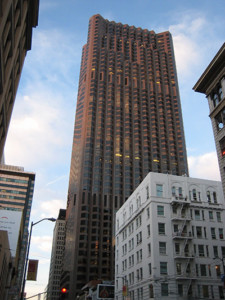
International Women’s Day – A Tribute to Margo Grant Walsh and Olive Chadeayne, AIA
When I first started working in the office of the Joint Venture Architects for the Bank of America Headquarters Building in San Francisco, I found myself in the midst of 50 architects and interior designers, located in an office on the 20th Floor of the still-under-construction high-rise. The Joint Venture was between Wurster Bernardi + Emmons and Skidmore Owings & Merrill, and the employees came from the two firms. (I was employed by WB+E.)
I also found myself surrounded by an amazing group of women — mostly interior designers, led by the incomparable Margo Grant Walsh and Charles Pfister, but with a sparse handful of women architects.
Margo was probably in her early 30’s. She led the design of the Bank of America offices throughout the building, from the main banking floor to the executive offices at the very top. Her design was elegant and yet appropriate for the workplaces that she was creating. She hired the best and the brightest — mostly women — and she led by example, with grace and joie de vivre. Whether we were working in the office or celebrating a milestone in someone’s life, she was sophisticated and self-assured. It’s no wonder that she became one of the most influential women in architecture and interior design.
Olive Chadeayne was one of the few women architects in the office. Back then (in 1969), she was in her early 60’s. She had grey hair and wore sensible walking shoes, because she took the bus from Berkeley to San Francisco every day and had to walk several blocks each way. (There was no BART yet in the SF Bay Area.) Although she wasn’t one of the most visible people in the office, Olive impressed me with her incredible organizational skills and quiet intelligence, as well as her comprehensive understanding of how to get things built. She sat at the first desk in the studio and had the onerous task of trying to translate architectural and interior design concepts into words, through the art and science of specifications writing. Although her work wasn’t as exciting as design, she relished the challenge and created graceful, articulate solutions.

The B/A project was built on a fast-track, negotiated contract. The traditional process would have been to design the project and then issue a set of contract documents (drawings and specifications) for bid. Instead, this project began with basic contract documents for the general contractor, and then, as additional elements of the building were designed, the JV architects issued “bulletins” that covered each specific element. Olive was responsible for the specifications and bulletins, and she issued new documents every few days to cover everything from changes in vertical transportation (elevators) to FF&E (furniture, furnishings & equipment) for the offices. Ultimately, there were more than 1,500 change orders (changes to the basic construction contract) on the project.
Olive had received her architectural degree from the University of California in the 1920’s, and as I recall, she was the only woman in her class. As a Cal graduate, she would have been attracted to the WB+E practice, since William Wurster became Dean of the School of Architecture in 1950 and later founded the College of Environmental Design there. (The architecture building is Wurster Hall.) His San Francisco firm was a seminal practice, and the list of former employees was a who’s who of architecture in the Bay Area, including Joseph Esherick and Art Gensler. According to the IAWA archive, she passed away in 2001.
Although Olive didn’t become as well-known as Margo, both of them had a remarkable influence on all of us who worked with them. It is because of women like these that so many women have been able to build careers of their own in architecture and design.
Thank you, ladies!
* * *
Penny Rozis, one of my friends from the B/A JV team, pointed out that I had mistaken Olive’s first name. (The original post identified her as Iris Chadeayne. Bad, Marjanne!) Thanks to the correction, I found the link to her history in the International Archive of Women in Architecture. For more information about Olive, click here and scroll to her name. You’ll be able to read part of her oral history, from a conversation with another dear friend, Elizabeth O’Hara.

